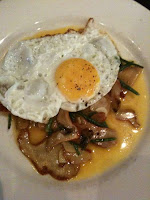 They smelled good. They were topped with bacon. When I asked if he wanted to know what he was trying before he took a bite, he declined. And that's how my 11-year old son came to eat lamb balls at Incanto.
They smelled good. They were topped with bacon. When I asked if he wanted to know what he was trying before he took a bite, he declined. And that's how my 11-year old son came to eat lamb balls at Incanto. |
| image via @offalchris |
Chef Chris Cosentino has that skill, and has been one of the most prominent and vocal champions of offal cookery (along with perhaps his kindred spirit in England, Fergus Henderson). So his restaurant in Noe Valley was one of my "don't miss" destinations on our current San Francisco trip. And Frod Jr. was on clear notice that whatever he was taking a taste of could have come from just about anywhere on or in the animal.
Incanto looks much like many other Italian restaurants, with rough-cut stone floors, simple dark wood furniture, and a series of columns and arches that separate a partially open kitchen from the bustling, boisterous dining room. One thing that's a little different is the glass case of house-cured salumi on display as you walk in (this love of cured meats has expanded into a side business for Chef Cosentino, who now produces several "tasty salted pig parts" for retail sale through Boccalone, with an outpost in the Ferry Building). Many of those pig parts can be sampled on an antipasto platter at Incanto; and the menu, with a leaning towards starter-sized items and almost all pastas available in half portions, lends itself to trying a variety of dishes.
We started with the antipasto platter, which our server helpfully advised was also available in a 1/2 portion, even though this was not listed on the menu. My memory has faded a bit at this point, but I believe it featured some mortadella, prosciutto cotto (a cooked ham, delicately spiced and more sweet than salty), soppressata, porchetta di testa (rolled pig's head, thinly sliced), and a pork paté, along with some nice bright pickled vegetables. All were quite good, and surprisingly conservative with the salt - almost to the point where I thought they could have used a touch more. Some nice crusty bread, along with focaccia and breadsticks, were accompanied by a black olive tapenade.
 |
| image via @offalchris |
The lamb fries were also a starter, and were done in a piccata style with bacon. They came, as I guess can be expected, two to an order.[*] The fries were actually a wonderful delicate texture, similar to sweetbreads or fish quenelles. They had a lightly meaty flavor with maybe just the slightest hint of iron, as in liver. And they were soaking in melted butter spiked with capers, topped off with a few strips of salty savory bacon. I thought they were genuinely delicious; Frod Jr., while he didn't go back for a second bite, didn't think they were bad (until after I told him what they were; and even then, he admitted he was more bothered by the idea rather than the flavor).
Next, a 1/2 order of the spaghettini with Sardinian cured tuna heart, egg yolk and parsley. I've had and enjoyed a similar dish at Sardinia Ristorante in Miami made with bottarga, the dried and cured roe sac of a tuna. The cured tuna heart has a flavor very similar to the bottarga, salty and with a deep funky marine whiff to it. It was generously shaved over the hot spaghettini, which had been tossed with olive oil, many slivers of browned garlic and a handful of fresh parsley, and topped with a raw egg yolk which is then lightly cooked by the heat of the pasta as you further toss the pasta yourself.
But Chef Cosentino's cooking is not just about offal. A handkerchief pasta sauced with a pork ragu was just flat-out good cooking. The pasta was just about perfect, supple and smooth without being insipid and limp; and the rustic meat sauce was rich, tender and hearty. Nothing unusual or exotic about this, just a delicious pasta dish.
 |
| what was left of the beef rib |
The wine list, if I recall, was almost exclusively Italian wines, and showed some nice breadth both regionally and in price ranges. A 2003 Fanetti Vino Nobile di Montepulciano Riserva hit the appropriate note of refined rusticity to match the food.
And that is perhaps the best way I can think of to describe the cooking at Incanto - refined rusticity. While much of the attention is paid to Chef Cosentino's work with offal, I think perhaps that angle is overworked to a degree. It's exciting to explore the different flavors and textures that can be offered by the "fifth quarter," but unless it's done well, it's just something to brag about to your friends, which to me is infinitely less rewarding than a genuinely great meal. In our experience, whether it was lamb fries or pasta with pork ragu, this was just good, satisfying food.
Incanto
1550 Church Street
San Francisco, CA 94131
415.641.4500
[*]As good as they were, I don't think I could eat 28:


